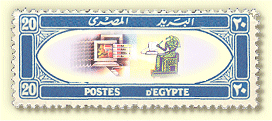PRESENT: Thirteen members were present; apologies were received from seven members.
Again (too) much of the meeting was devoted to discussing arrangements for London 2010 and the Anniversary luncheon. To avoid boring members with the flow and counter-flow of occasionally heated discussion, let it suffice here to summarise the decisions made. More information will be found in the QC.
The meeting was delighted to hear that Professor Peter Smith, our longest service member and long-term mentor, was planning to attend London 2010. Before discussion was opened, member ESC 266 was able to announce that Ronny Van Pellecom (ESC 618) was well advanced with a newly researched book on Ramleh, the Alexandria suburb, detailing its history, geography and postal details. He showed a draft version, which impressed members with its breadth, depth and comprehensive illustrations. It is hoped that this volume will join the Rural Post book by Mike Murphy and Ibrahim Shoukry on sale at London 2010.
Points from the meeting:
1. There will be a one-frame (11 sheets + introduction) display at the luncheon. Members - especially those from overseas - are invited to contact the Secretary if they wish to display. Genuine material only: the frames are not secure, but members will be on hand throughout and we hope to have unusual material on show.
2. UK members, partners and guests are asked to pay £55 per head for the luncheon, while foreign members and partners will not be required to pay but will have bookings accepted if accompanied by a refundable remittance of the same amount. Overseas members' guests should pay the £55. We regret that numbers will be limited, and that no bookings will be accepted after April 1.
3. Volunteers will be required to help to "man" the London 2010 table we shall share with the Sudan Study Group. We shall display the two books mentioned above, the colour QC, general information, and we are planning small packets of stamps to give to interested young would-be collectors.
4. The Annual General Meeting will be held at Stampex on February 27: please remember that all 2010 subscriptions (in fact due on January 1) must be paid by the date of the AGM or privileges may be withdrawn. The idea of a live auction was not followed through.
5. In response to the Secretary's "Why are you a member?" note in the last QC, several messages had been received - thank you very much! - with several new ideas put forward. It is clear that more, and perhaps more basic, information is required on this website. We shall move to provide this by giving access to more material in the members' area, including QC back copies and pages from the Postal Bulletins.
6. The Circle apologises to those whose lots won in the last Auction were delayed by circumstances beyond our control, viz, the UK postal strike, and hope that by now everyone has received his material. There will be only one Auction next year, timed to coincide with London 2010; and we hope to make it massive. Will all members please submit lots for the sale by March 15.
We also apologise to Dennis Clarke (ESC 165), who had volunteered to talk at great personal cost in terms of both time and money, and then found his display caught up behind discussion of next year's affairs. Despite the shortage of time, he battled manfully to give a professional printer's insight into the intricacies of both lithography and typography, illustrated with a quite astonishingly comprehensive collection of interpostals of all types and hues. The sheets displayed bore witness both to his deep knowledge and to the care and attention lavished on each individual page, with detailed drawings and explanations accompanying staggeringly rare material which included proof sheets of Alexandria Interpostals, as well as examples from all the consular offices abroad.
All of this was used to consolidate explanations of the differences between lithography (which works because grease and water repel each other: the image is drawn in reverse with a greasy crayon on stone which is then covered with a thin film of water. The oily ink sticks to the greasy image but not to water-covered areas, and is then transferred to applied paper); and typography (where the final image is produced by taking an impression from inked upstanding lead characters arranged to form a phrase or saying, or with the addition of engraved illustrative features). In chromo-lithography, as in multicolour typography, the image may gradually be built up by passing the paper several times over the printing surface, each time in a different colour.
On behalf of the Circle member ESC 266 expressed the gratitude of members, paid tribute to Dennis's painstaking knowledge and fortitude and thanked him for a fascinating display.
|

